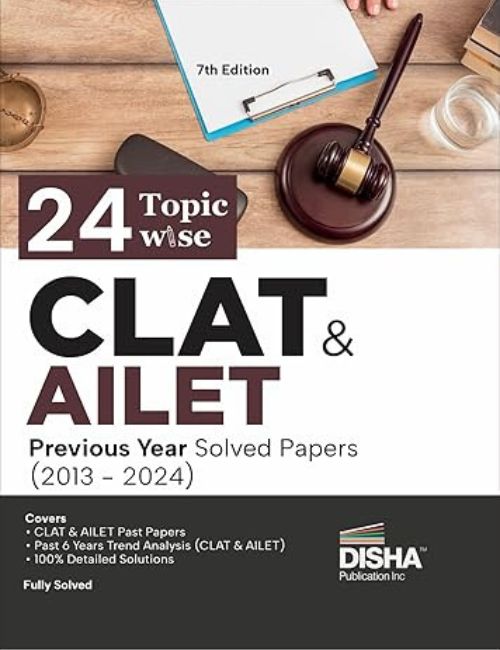CLAT Previous Year Question Papers PDF (2008-2025)
If you’re preparing for CLAT, practicing with actual exam papers from previous years is a powerful strategy. Here, you’ll find the complete set of CLAT previous year question papers with answers PDF download from 2008 to 2025.
Practicing and analyzing these previous year question papers of CLAT gives you a clear view of recurring question patterns, difficulty levels, and essential topics for each section.
Download these resources and boost your preparation by learning from the real exam format used over the years.
Book Free Counselling for CLAT 2026!
Get a callback and ask anything about CLAT: preparation, syllabus, scholarship, etc.
Benefits of Solving CLAT Previous Year Question Papers (PYQ)
1. Understand Exam Pattern
2. Familiarize Yourself with Question Types
3. Identify Important Topics
4. Enhance Time Management Skills
Time management for CLAT is critical. Practicing with previous year CLAT papers under timed conditions helps you gauge the time required per section, allowing you to pace yourself effectively.
5. Build Exam Stamina and Focus
Solving past papers of CLAT helps you build the mental stamina to stay sharp for the exam’s full duration, reducing fatigue and keeping your focus strong from the first question to the last.
6. Improve Speed and Accuracy
7. Assess Your Preparation Level
8. Gain Confidence
9. Develop Problem-Solving Techniques
10. Track Progress Over Time
- No. of questions: 120
- Maximum marks: 120
- Duration: 2 hours
- English- 24
- Current Affairs & GK- 28
- Legal Reasoning- 32
- Logical Reasoning- 24
- Quantitative Techniques- 12
- No. of questions: 120
- Maximum marks: 120
- Duration: 2 hours
- English- 24
- Current Affairs & GK- 28
- Legal Reasoning- 32
- Logical Reasoning- 24
- Quantitative Techniques- 12
CLAT Question Paper 2022
- No. of questions: 150
- Maximum marks: 150
- Duration: 2 hours
- English- 30
- Current Affairs & GK- 35
- Legal Reasoning- 40
- Logical Reasoning- 30
- Quantitative Techniques- 15
- No. of questions: 150
- Maximum marks: 150
- Duration: 2 hours
- English- 30
- Current Affairs & GK- 35
- Legal Reasoning- 40
- Logical Reasoning- 30
- Quantitative Techniques- 15
- No. of questions: 150
- Maximum marks: 150
- Duration: 2 hours
- English- 30
- Current Affairs & GK- 35
- Legal Reasoning- 40
- Logical Reasoning- 30
- Quantitative Techniques- 15
- No. of questions: 150
- Maximum marks: 150
- Duration: 2 hours
- English- 30
- Current Affairs & GK- 36
- Legal Reasoning- 39
- Logical Reasoning- 45
- Quantitative Techniques- 15
- No. of questions: 200
- Maximum marks: 200
- Duration: 2 hours
- English- 30
- Current Affairs & GK- 50
- Maths- 20
- Logical Reasoning- 40
- Legal Aptitude- 50
CLAT Question Paper 2018
- No. of questions: 200
- Maximum marks: 200
- Duration: 2 hours
- English- 30
- Current Affairs & GK- 50
- Maths- 20
- Logical Reasoning- 40
- Legal Aptitude- 50
CLAT Question Paper 2017
- No. of questions: 200
- Maximum marks: 200
- Duration: 2 hours
- English- 30
- Current Affairs & GK- 50
- Maths- 20
- Logical Reasoning- 40
- Legal Aptitude- 50
CLAT Question Paper 2016
- No. of questions: 200
- Maximum marks: 200
- Duration: 2 hours
- English- 30
- Current Affairs & GK- 50
- Maths- 20
- Logical Reasoning- 40
- Legal Aptitude- 50
CLAT Question Paper 2015
- No. of questions: 200
- Maximum marks: 200
- Duration: 2 hours
- English- 30
- Current Affairs & GK- 50
- Maths- 20
- Logical Reasoning- 40
- Legal Aptitude- 50
CLAT Question Paper 2014
- No. of questions: 200
- Maximum marks: 200
- Duration: 2 hours
- English- 30
- Current Affairs & GK- 50
- Maths- 20
- Logical Reasoning- 40
- Legal Aptitude- 50
CLAT Question Paper 2013
- No. of questions: 200
- Maximum marks: 200
- Duration: 2 hours
- English- 30
- Current Affairs & GK- 50
- Maths- 20
- Logical Reasoning- 40
- Legal Aptitude- 50
- No. of questions: 200
- Maximum marks: 200
- Duration: 2 hours
- English- 30
- Current Affairs & GK- 50
- Maths- 20
- Logical Reasoning- 40
- Legal Aptitude- 50
- No. of questions: 200
- Maximum marks: 200
- Duration: 2 hours
- English- 30
- Current Affairs & GK- 50
- Maths- 20
- Logical Reasoning- 45
- Legal Aptitude- 45
- No. of questions: 200
- Maximum marks: 200
- Duration: 2 hours
- English- 30
- Current Affairs & GK- 50
- Maths- 20
- Logical Reasoning- 40
- Legal Aptitude- 50
- No. of questions: 200
- Maximum marks: 200
- Duration: 2 hours
- English- 30
- Current Affairs & GK- 50
- Maths- 20
- Logical Reasoning- 45
- Legal Aptitude- 45
- No. of questions: 190
- Maximum marks: 190
- Duration: 2 hours
- English- 40
- Current Affairs & GK- 100
- Maths- 10
- Logical Reasoning- 25
- Legal Aptitude- 15
Get up to 100% Scholarship for CLAT Coaching!
How to Use CLAT Previous Year Papers Effectively?
1. Start with a Baseline Assessment
2. Review Solutions Thoroughly
3. Identify Recurring Topics and Patterns
4. Develop Sectional Strategies
5. Set a Timer for Practice
6. Create a Mistake Log
Keep a record of all errors and challenging questions across previous year papers of CLAT. Revisiting this log periodically helps reinforce your learning and serves as a quick revision tool before the exam.
7. Analyze Performance Trends
8. Simulate Exam Day
As the CLAT exam date approaches, select a recent previous year paper and take it under strict exam-like conditions. This full-length practice session helps reduce anxiety and prepares you mentally for the big day.
9. Balance with New Practice Questions
Attempt New Practice Questions:
- CLAT Legal Reasoning Mock Test (Free)
- CLAT Logical Reasoning Mock Test (Free)
- CLAT English Mock Test (Free)
10. Revise with Answer Keys
Most Useful Resources for Preparation:
CLAT Previous Year Question Paper Books
1. 24 Topic-Wise CLAT & AILET (2013 - 2024) Previous Year Solved Papers by Disha Publication

2. Previous Years' Papers of CLAT, AILET, and Other Law Entrance Examinations by Pearson

3. CLAT Solved Papers [Year-wise] by LearnX

FAQs About CLAT Past Year Papers
What is the importance of solving CLAT PYQ for preparation?
Practicing CLAT PYQs helps understand the exam pattern, recurring topics, and question difficulty levels.
Where can I find CLAT previous year question paper PDF downloads?
Law Prep Tutorial offers CLAT previous year question paper PDFs, with answer keys for efficient practice.
How many years of CLAT previous papers should I solve?
Solving at least the last 10 years of CLAT papers is beneficial for thorough preparation.
Can I download the last year CLAT question paper for free?
Yes, Law Prep Tutorial offers the previous year’s CLAT paper for free download.
How do CLAT previous year papers help in time management?
Practicing with real CLAT papers under timed conditions helps improve speed and manage exam time effectively.
Where can I get CLAT question paper PDFs with answer keys?
You can find CLAT question paper PDFs along with answer keys on website of Law Prep Tutorial.
How many CLAT previous year papers are available?
CLAT has been held annually since 2008, so 16+ papers are available for practice.
Is it necessary to solve the last year CLAT question paper?
Yes, solving the latest paper gives insight into the most recent question trends and difficulty level.
What is the best way to approach CLAT PYQ?
Attempt each paper under timed conditions, review answers, and focus on improving weak areas.
How does the last year CLAT question paper differ from previous ones?
Each year’s paper can vary in question types and difficulty, which is why solving multiple years is beneficial.
How should I review my answers on CLAT previous year papers?
Use answer keys to assess each question and analyze mistakes to improve your understanding of the topics.
Should I start with the most recent CLAT PYQ or older ones?
It’s often beneficial to start with recent papers and then work backward to notice patterns and skill improvements.
How effective is the last year CLAT question paper for mock practice?
Very effective, as it gives insight into the latest question styles and lets you gauge readiness under real exam conditions.
Should I time myself when solving CLAT PYQs?
Absolutely. Timing yourself simulates real exam conditions, helping build speed and exam stamina.
Do CLAT previous year papers reflect the current exam pattern?
While the exam pattern evolves, previous papers provide a good foundation and familiarize you with CLAT’s structure.


